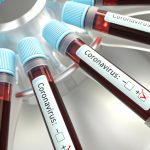 On March 17, Gautret et al. published a manuscript reporting beneficial effects from hydroxychloroquine in COVID-19 in the International Journal of Antimicrobial Agents.1 At a presidential press conference three days later, President Trump discussed hydroxychloroquine, asserting, “It’s shown very encouraging—very, very encouraging early results.” Shortly thereafter, pharmacies around the world reported shortages. Kaiser Permanente went so far as to restrict access to hydroxychloroquine, including for many patients with rheumatic conditions. Rheumatologists everywhere have been left wondering what happened and how to move forward.
On March 17, Gautret et al. published a manuscript reporting beneficial effects from hydroxychloroquine in COVID-19 in the International Journal of Antimicrobial Agents.1 At a presidential press conference three days later, President Trump discussed hydroxychloroquine, asserting, “It’s shown very encouraging—very, very encouraging early results.” Shortly thereafter, pharmacies around the world reported shortages. Kaiser Permanente went so far as to restrict access to hydroxychloroquine, including for many patients with rheumatic conditions. Rheumatologists everywhere have been left wondering what happened and how to move forward.
At first glance, the enthusiasm for hydroxychloroquine had merit. Multiple in vitro studies have demonstrated encouraging results, and unpublished reports from China suggested a clinical benefit.2,3 Hydroxychloroquine has an acceptable safety profile and a reasonable cost. An editorial in mid-February by Didier Raoult, also the senior author of the Gautret paper, made the audacious claim, “If clinical data confirm the biological results, the novel coronavirus-associated disease will have become one of the simplest and cheapest to treat and prevent among infectious respiratory diseases.”4
Clinical data arrived just four weeks later, when Gautret et al. published their experience treating COVID-19 with hydroxychloroquine in the south of France. The manuscript evaluated 42 patients with PCR-confirmed COVID-19 and reported virological cure in 14 of 20 patients (70%) treated with six days of hydroxychloroquine. Only two of the 14 patients in the control group had a virological cure six days after enrollment. All six patients who also received off-protocol azithromycin cleared the virus. Although small, the results appeared to confirm biological data. A closer read of the manuscript, however, suggests otherwise.
Typical of preliminary data, the trial was small, open-label and non-randomized. Studies of this nature suffer from bias and confounding, and frequently do not translate into successful phase 2 or 3 trials. Whether this study is a “trial,” however, should also be questioned. Although the treatment group was recruited from a single center, the control group was recruited separately from various hospitals in the region. Even more troubling, patients who refused or could not tolerate hydroxychloroquine were included in the control group. This design more closely resembles an unnecessarily biased case-control study than a clinical trial. Its results should have been presented and interpreted as such.
Methodological flaws after recruitment compound problems with interpretation of their data. The primary outcome measure, viral clearance at six days, has not been validated and does not necessarily correlate with outcomes that are clinically relevant, such as mortality. Testing of the control group was less rigorous than testing of the treatment group, and almost half of the control group required imputation of their virus results. Most importantly, six of 26 (23%) patients in the treatment group were lost to follow-up and excluded from subsequent analysis. These included patients with the most relevant clinical outcomes, including adverse events (one patient), ICU transfer (three patients) and death (one patient).
Data contradicting the conclusions of this study have already begun to emerge, including a single-center, open-label, randomized, controlled trial of 30 patients with COVID-19 recently published by Jun et al. in the Journal of Zhejiang University.5 Contrary to the paper by Gautret et al., this study found no significant difference with regard to viral clearance among patients who received hydroxychloroquine (13 of 15; 87%) or usual care (14 of 15; 93%). Neither study was adequately powered to address meaningful outcomes or serve as the basis for strong recommendations. Multiple larger randomized controlled trials are actively recruiting (ClinicalTrials.gov), but their results may not be available for many months.
In the meantime, it seems likely that hospital systems and providers will prescribe hydroxychloroquine to patients with COVID-19. Although the data supporting its use are of low quality, no studies to date have been sufficiently rigorous to refute this practice. Unpublished reports from China have reportedly been promising, and the preclinical mechanistic studies support the bioplausibility of hydroxychloroquine as a treatment for COVID-19. Many rheumatologists have become accustomed to recommending hydroxychloroquine as a generally well-tolerated therapy; we should forgive others for feeling similarly in the face of a pandemic. In the near term, at least, we will have to adapt to this new reality.
Adaptation does not mean acquiescence, however, and we should encourage rational use of hydroxychloroquine whenever possible. No data exist for prescribing hydroxychloroquine for post-exposure prophylaxis, and we should not prescribe it for this indication. Patients already taking hydroxychloroquine should be discouraged from sharing their valuable supply or from increasing their doses. For a patient with rheumatoid arthritis or lupus, the harm from running out of hydroxychloroquine seems likely to outweigh any possible benefit to others with regard to COVID-19. Finally, we and other providers should not write prophylactic prescriptions for ourselves or our family. We should be held to the same standards we recommend in practice, which dictate judicious use of this valuable medication.
In addition to avoiding these practices, we can take a number of positive steps to lessen the impact of hydroxychloroquine shortages:
- Hydroxychloroquine has a half-life of many weeks, and in many cases, the answer to a few missed doses should be reassurance;
- Build a list of pharmacies in your area that have supplies available, and be ready to direct your patients appropriately;
- Engage with your medical center to ensure that patients with rheumatologic diseases have a voice at the table when treatment algorithms are created; and
- Above all, be available. Prophylactic phone calls and responding quickly to patient queries will be necessary to assuage their reasonable concerns.
Reasons for optimism also exist. Enthusiasm for hydroxychloroquine at the highest level of government should encourage rapid escalation of production. Pharmaceutical companies, including Mylan, Teva, Amneal and Novartis, have pledged to produce or donate nearly 200 million doses. If these totals materialize or convincing data refute Gautret et al.’s findings, the supply of hydroxychloroquine should return to normal before our patients experience substantial harm.
Regardless of the outcome, the recent experience with the hydroxychloroquine shortage should remind us to critically appraise the medical literature. Had the limitations of the study by Gautret et al. been more clearly articulated by the authors themselves or by the medical community at large, the current shortage may have been averted. It should also remind us that our patients will face new and unforeseeable challenges in the months to come. Despite the hurdles of telemedicine and social-distancing-rheumatology, we must find ways to help them through this crisis.
 Michael Putman, MD (@EBRheum), is a clinical instructor of medicine at Northwestern University, Evanston, Ill., and a member of the ACR’s Fellows-in-Training Subcommittee. He is pursuing large vessel vasculitis research on a T32 training grant.
Michael Putman, MD (@EBRheum), is a clinical instructor of medicine at Northwestern University, Evanston, Ill., and a member of the ACR’s Fellows-in-Training Subcommittee. He is pursuing large vessel vasculitis research on a T32 training grant.
References
- Gautret P, Lagier J-C, Parola P, et al. Hydroxychloroquine and azithromycin as a treatment of COVID-19: Results of an open-label non-randomized clinical trial. Int J Antimicrob Agents. 2020 Mar 20;105949. (Online ahead of print)
- Wang M, Cao R, Zhang L, et al. Remdesivir and chloroquine effectively inhibit the recently emerged novel coronavirus (2019-nCoV) in vitro. Cell Res. 2020 Mar;30(3):269–271.
- Cortegiani A, Ingoglia G, Ippolito M, et al. A systematic review on the efficacy and safety of chloroquine for the treatment of COVID-19. J Crit Care. 2020 Mar 10. (Online ahead of print)
- Colson P, Rolain JM, Raoult D. Chloroquine for the 2019 novel coronavirus SARS-CoV-2. Int J Antimicrob Agents. 2020 Mar;55(3):105923.
- Chen J, Liu D, Liu L, et al. A pilot study of hydroxychloroquine in treatment of patients with common coronavirus disease-19 (COVID-19). J Zhejiang Univ (Med Sci). 2020;49(1). doi:10.3785/j.issn.1008-9292.2020.03.03
Editor’s note: The ACR offers recommendations regarding the allocation of hydroxychloroquine (HCQ) during the COVID-19 pandemic and recommendations regarding the allocation of IL-1 and IL-6 and JAK antagonists during the pandemic. All recommendations are based on current knowledge and are subject to revision as circumstances evolve.



